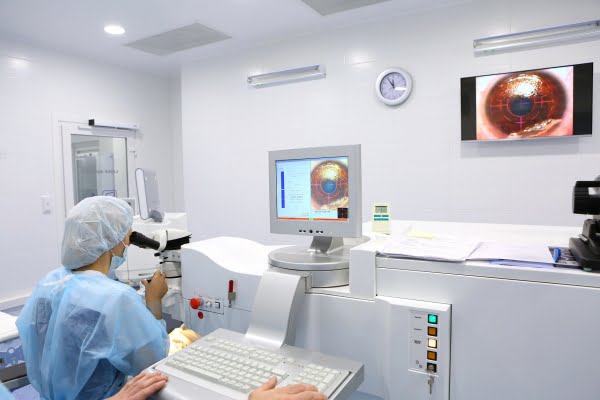
Cataracts are a common age-related vision condition impacting more than 25 million Americans. When cataracts develop, your eye’s lens becomes cloudy, preventing it from focusing light properly on your retina. Over time, this results in a gradual deterioration of your vision and if left untreated, cataracts can eventually lead to blindness.
Fortunately, cataract surgery provides a safe and effective way to restore clear vision. During your procedure, your eye’s cloudy natural lens is removed and replaced with a clear, artificial lens called an intraocular lens (IOL).
Traditionally, the incisions during cataract surgery were made using a blade. While this method can deliver good results, advances in technology have given our ophthalmologists a more effective way to perform your procedure. The iCataract procedure replaces the blade used for your incision with a laser. Laser cataract surgery improves the precision and quality of this incision, allowing us to deliver the exceptional results you deserve.
Difference between Traditional Cataract Surgery and the iCataract Procedure
During traditional cataract surgery, a blade is used to make an incision in your cornea. This allows our ophthalmologists to access your eye’s lens in order to replace it with an IOL. The incision process is a crucial part of the procedure. The placement and size of these incisions can have a significant impact on the quality of vision you achieve from cataract surgery.
With the iCataract procedure, this entire step is performed using state-of-the-art femtosecond laser technology. Our ophthalmologists will use digital 3D imaging technology to create a detailed map of your eye. This map guides the surgical planning software, providing a truly customized procedure. As a result, your incisions are highly accurate and reflect the proper specifications required for the size, shape, depth and curvature of your eyes. By using a laser for this process, our ophthalmologists have greater control over the incision, ensuring the highest levels of precision.
After the incision is made, the cataract is broken up using a process called phacoemulsification. In traditional cataract surgery, ultrasonic energy is used for the entire phacoemulsification process. During laser cataract surgery, a laser is used as a preliminary step to break the cataracts into smaller pieces. This reduces the amount of ultrasonic energy required for phacoemulsification, which can lead to a shorter recovery time and a reduced risk of complications.
In both procedures, your eyes natural lens will be removed after the cataracts have been broken up, and an IOL will be inserted in order to restore clear vision.
Benefits of Laser Cataract Surgery
You will experience several important benefits when you choose laser cataract surgery:
- Improved precision and accuracy throughout the surgical process
- More predictable results
- Greater comfort
- Highest levels of safety
- Reduction in surgical inflammation
- Provides a higher degree of correction for astigmatism
- More precise opening and removal of the lens capsule, which reduces the likelihood that your IOL will become displaced
Contact our Scranton/Wilkes-Barre Cataract Surgeons
Please contact Northeastern Eye Institute using the form on this page or call 855-204-6888 today to schedule a cataract surgery consultation. We have 15 locations conveniently located in Scranton, Wilkes-Barre and throughout Northeastern Pennsylvania.